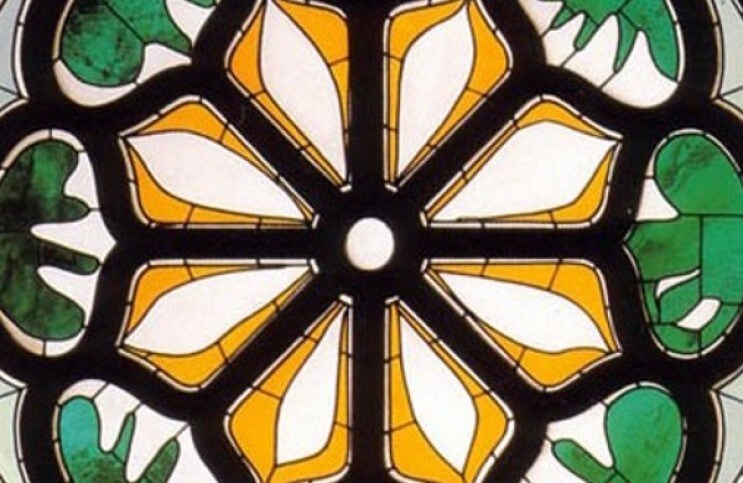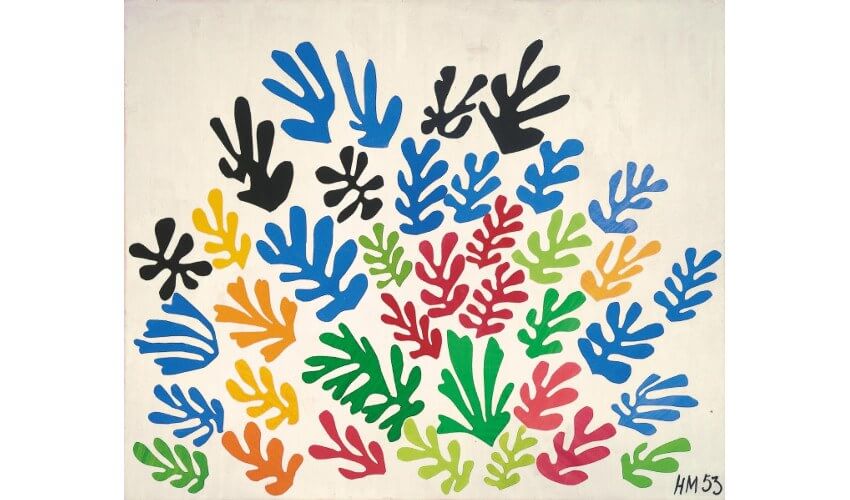
Painting with Scissors - Why We Love Henri Matisse Cut Outs
The final artwork by Henri Matisse can not be found in a museum. It is a window, dubbed the rose window, high on a rear wall of Union Church in Pocantico Hills, a riverside hamlet 25 miles north of Manhattan. It is the last of the iconic Matisse cut outs, rendered in stained glass. Accompanying the window are nine other stained glass windows designed by Marc Chagall, one of them monumental in scale. But it is the Matisse, unassuming and easy for the uninformed to miss, that draws crowds. Nelson A. Rockefeller commissioned the work for his mother, Abby Rockefeller, one of the founders of the New York MoMA and an avid Matisse supporter. The Rockefeller family built the church. Their family estate, Kykuit, is nearby. Matisse completed the design for the window at age 84, and shortly after died. It represents the epitome of his lifelong path toward simplification. In particular it testifies to the accomplishments of what he called “une seconde vie,” or his second life. Having already earned a reputation as one of the finest artists who ever lived, Matisse developed what he thought was terminal cancer at age 72. After unexpectedly surviving treatment, he became re-energized. Freed by the simplicity his newly limited mobility demanded, he embraced the cut out technique that ultimately dominated the final decade of his life, and which led to his most memorable body of work.
The Church of Matisse Cut Outs
Although the rose window in New York is notable as the last artwork Matisse made, a far grander example of his cut out aesthetic can be seen at another church, the Chapelle du Rosaire, located in the French Riviera town of Vence. Matisse moved to Vence around 1943, two years after surviving his duodenal cancer surgery. While recovering earlier in Nice, he had hired a part-time nurse named Monique Bourgeois. After discovering her interest in art, Matisse mentored her as she helped him recuperate. When she later declared her intention to enter a convent in Vence, Matisse followed her there.
When the Dominican convent Bourgeois joined then planned to build a chapel, Matisse agreed to help design it. He spent four years on the project. He designed every element of the environment: the architecture, the stained glass windows, the furniture, the frescoes, even the textiles and robes for the priests. Every aesthetic element of the project was planned using his cut out technique. Though not a religious person, Matisse considered the chapel his masterpiece, calling it the culmination of everything he had learned in his life as an artist up to that point.
 The Chapelle du Rosaire de Vence and priest vestments designed by Matisse using his cut out technique
The Chapelle du Rosaire de Vence and priest vestments designed by Matisse using his cut out technique
The Early Cut Outs
But it is a common fallacy to think Matisse only invented his cut out technique after falling ill. He had actually been making cut outs for most of his life. He simply never saw them before as worthy of his entire attention. Matisse was born in the commune of Bohain-en-Vermandois, in Northern France. The area was the center of the silk business at the time, and for generations his family had supported themselves as weavers. He was raised cutting patterns for textiles and clothes, pinning them together in much the same way as he later assembled his cut outs on the walls of his home.
As early as 1919, Matisse was even using cut outs in his own artwork. That was the year he was commissioned to design the stage decorations for the ballet debut of The Song of the Nightingale, the first opera by Igor Stravinsky. Cardboard reproductions of the walls of the set were sent to Matisse in his studio in Nice. He created his designs with cut outs, pinning them to the cardboard walls, rearranging them to find the perfect composition. He designed the costumes in the same manner, creating pieces that anticipate his later designs for the priest vestments at the Chapelle du Rosaire de Vence.
 Two Matisse costumes for the premier production of The Song of the Nightingale, by Igor Stravinsky
Two Matisse costumes for the premier production of The Song of the Nightingale, by Igor Stravinsky
Rouge et Noir
Nineteen years after making his designs for Igor Stravinsky, Matisse again received an opportunity to employ the cut out technique on a stage production. This time, it was for the 1938 production of a ballet called Rouge et Noir, starring the famed Russian dancer and choreographer Léonide Massine. According to legend, Massine was creatively stuck when he happened to visit Matisse one day in his studio. Matisse was working on designs for the Dance Mural, a monumental commission for the Barnes Foundation in Philadelphia.
Massine saw the images of the dancers and became inspired. He later recollected, “I pointed out to [Matisse] that they were very similar in conception to the ballet I was planning, which I visualized as a vast mural in motion.” He commissioned Matisse on the design the set and costumes for his production. To create his proposal for the show, Matisse first painted sheets of paper in brightly colored gouache then cut out the shapes, intricately laying out designs for the backdrop, the curtain and the costumes. He later even applied cut out shapes directly to the bodies of the performers.
 A pinned together cut out by Matisse for Rouge et Noir (left) and the artist working on a costume for the show (right)
A pinned together cut out by Matisse for Rouge et Noir (left) and the artist working on a costume for the show (right)
Brushes With Doom
One year after the production of Rouge et Noir, the Nazis invaded Poland. And that same year, Henri Matisse lost his wife when she divorced him after discovering he was having an affair with one of her friends, the much younger Lydia Delectorskaya. The Nazis invaded France a year after that. Many French artists, like artists in so many other countries threatened by the Nazis, fled to America if they could to avoid the war. But Matisse did not flee, though he easily could have. He never officially joined the resistance (as his daughter did), but he did remain in the country, which was a source of inspiration to many French citizens, that their greatest living artist would not abandon them.
It was in the thick of the Occupation that Matisse developed cancer. Stunned by the war, his divorce, and now a seemingly terminal disease, he committed himself to the notion he would not survive, even writing a goodbye letter making amends with his former wife of 41 years, Amélie. But miraculously he lived, though he was relegated almost entirely to bed rest or a wheelchair. So rather than painting or sculpting, he concentrated on the technique he had been developing in the background all along: cut outs. He enlisted his young mistress-turned-studio assistant Lydia Delectorskaya to paint sheets of paper with gouache, which he then cut into shapes.
 Henri Matisse - The Sheaf, 1953, Gouache on paper mounted on canvas. From the collection of UCLA, © Succession H. Matisse, Artists Rights Society
Henri Matisse - The Sheaf, 1953, Gouache on paper mounted on canvas. From the collection of UCLA, © Succession H. Matisse, Artists Rights Society
The Book of Jazz
Despite limited mobility, the years following his cancer surgery became some of the most prolific of his life. Henri Matisse found in the cut out technique total release from creative apprehension, and a complete sense of joy. He called it “painting with scissors.” After using it to bountifully decorate his living space, he said, “I have made a little garden all around me where I can walk... There are leaves, fruits, a bird.” He once asked an assistant to drive him to a pool so he could see the divers. But finding no divers he instead returned home and created his monumental cut out mural The Swimming Pool, which today is part of the collection of the New York MoMA.
Perhaps the most endearing relic from this time in his life is an artist book called Jazz. Matisse created 20 abstract cut out collages originally conceived of as cover illustrations for a magazine called Verve, published by a company called Tériade. But instead the cut outs became the basis for vivid color prints released as a book. Jazz features full page and half page illustrations interspersed with the written thoughts Matisse had while making the images, writ large. He considered the book a jazz-like improvisation of rhythm and color. Only 100 were printed. But when the book came out, Matisse realized that the flat images betrayed the exciting texture of the original cut outs. It was that realization that inspired him to continue building the pinned-up, sculptural, textured cut outs that we remember him most for today, and which defined the brilliant, colorful aesthetic of “une seconde vie,” his second life.
 Henri Matisse, The Swimming Pool, 1952, Gouache on paper cut outs on burlap, nine panels. From the collection of The Museum of Modern Art, New York, © 2014 Succession H. Matisse / Artists Rights Society
Henri Matisse, The Swimming Pool, 1952, Gouache on paper cut outs on burlap, nine panels. From the collection of The Museum of Modern Art, New York, © 2014 Succession H. Matisse / Artists Rights Society
Featured image: Henri Matisse - detail of the rose window, Union Church, Pocantico Hills, New York
All images used for illustrative purposes only
By Phillip Barcio






